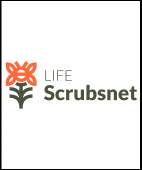
LIFE Project: Revitalizing extensive semi-arid agricultural habitats through the sustainable management of their associated scrubland areas
- Type Project
- Status In progress
- Execution 2021 -2026
- Assigned Budget 2.329.866,00 €
- Scope Europeo
- Autonomous community Extremadura
- Main source of financing LIFE
- Project website Web del proyecto
LIFE ScrubsNet focuses on the regeneration and enhancement of dehesas and their associated wildlife through the appropriate management of scrub/shrub areas as an essential element for the conservation of the entire ecosystem. The project will demonstrate the experimental development of a scrub mosaic management model to promote the environmental and economic sustainability of the dehesa, offering landowners a differentiated management alternative where natural capital is at the core of the system. The ultimate goal is to reconcile agricultural and habitat conservation policies in the dehesa, such that economic profitability is compatible with long-term persistence.
Much of Europe's biodiversity is closely linked to traditional and extensive agricultural practices. Agroecosystems represent 38% of the total area of the Natura 2000 network, mostly made up of extensive agricultural systems. In fact, 58 habitat types (of which 23 are priority habitats) under the EU Habitats Directive are considered key agricultural habitats, and a third of them are entirely dependent on appropriate agricultural practices, such as livestock farming or permanent or low-intensity cropping systems. Dehesas/montados (comprising habitat types 6310, 9330, and 9430) are characteristic of the Iberian Peninsula (around 3 million ha in Spain and Portugal) but are also present in Italy and France. Their conservation status has been repeatedly diagnosed as "unfavorable," mainly due to livestock intensification and the phytosanitary problems manifested in their ancient forests.
One of the key elements for the conservation and good health of the dehesa is its scrubland, but these have been eradicated in many extensive farms, resulting in habitat simplification, the emergence of diseases, and the consequent loss of biodiversity. Structurally diverse scrubland plays an important role in landscape diversification and the creation of habitat for many species, such as refuges for vertebrates, nesting sites for birds, and wintering sites for amphibians and reptiles. Scrubland also contributes to soil stability and function, among other socioeconomic and environmental benefits. Therefore, scrubland should be part of any sustainable dehesa habitat management model, especially within high-biodiversity habitat types, including Olea and Ceratonia forests (9320), and arborescent scrubland with Juniperus spp. (5210), Thermo-Mediterranean and pre-desert scrubland (5330), Mediterranean temporary ponds (3170*) and Pseudo-steppe with grasses and annual plants (Thero-Brachypodietea) (6220*).
- Protect, regenerate, and create key scrub/shrub areas in representative dehesas (four pilot farms in Extremadura, northwest Andalusia, and Alentejo) to improve biodiversity and productivity under an integrated management model.
- Implement specific conservation measures for threatened species associated with scrubland areas in the dehesa/montado included in the Habitats Directive.
- Improving the regeneration of the trees in the pastures (Quercus suber, Q. ilex, Q. rotundifolia, Q. coccifera and Q. faginea), with old trees being a key problem.
- Improve soil health and promote a natural barrier against pests and diseases by managing scrubland.
- Demonstrate the positive impact of project actions on biodiversity, soil, and socioeconomic factors.
- Improving policies and programs toward the sustainable conservation of dehesas in Natura 2000 areas and as connecting elements between Natura 2000 areas.
- Replicability and effective transfer of project results.
Improvement of over 200 ha of dehesa through the improvement of scrubland and pond areas, including the improvement of habitat types 3170* and 6220*.
Improvement of soil health in more than 40 ha (soil microorganisms and edaphic parameters: OM, pH, humidity).
Improvement in areas affected by Phytophthora cinnamomi (10 ha), including increased plant survival in affected areas.
Improving populations of indicator species of birds, insects, reptiles, amphibians and small mammals in scrubland areas:
- a) key bird species on pilot farms, including Sylvia undata, Galerida theklae, Lullula arborea, Emberiza hortulana and Milvus milvus.
- b) small mammals, especially Oryctolagus cuniculus (essential for Lynx pardinus* and Aquila adalberti*)
- c) reptiles and amphibians, namely Emys orbicularis, Mauremys leprosa, Lacerta schreiberi, Discoglossus galganoi and Lacerta lepida.
- d) arthropods (mainly pollinators)
Improvement of agri-environmental programmes in Extremadura (number of improved policies/programmes, number of competent authorities engaged), including green direct payments (greening), the different CAP support lines related to reforestation, silvo-environmental services and forest conservation, all of them reinforced for dehesas thanks to the project results, and at least 30% of EAFRD programmes aimed at supporting agri-environmental measures in the region, including measures for dehesas (currently not considered in EAFRD).
A scrubland mosaic management model to promote the environmental and economic sustainability of dehesa habitats.
- Coordinator/entity name: Juan Pablo Martin
Postal address: Santarem 4, 06011, Badajoz,
The project contributes to the implementation of the EU Biodiversity Strategy for 2030, the Habitats Directive, and the Birds Directive.
- Innogestiona Ambiental
- AGRIS(Agris Sardegna)
- Uévora(Universidade de évora)
- UEX(Universidad de Extremadura)
- JUNTAEX(Regional Government of Extremadura. General Directorate of Sustainability)
- PLASENCIA(Ayuntamiento de Plasencia)
- UCO(Universidad de Córdoba)
- IRNAS-CSIC(Institute of Natural Resources and Agrobiology of Seville (Spanish National Research Council))
- EXVER(EXTREMADURA VERDE S.L.)
- ECOHABITAT(Grupo Ecohábitat Ibérico S.L.)
- SEO(Sociedad Española de Ornitología)







